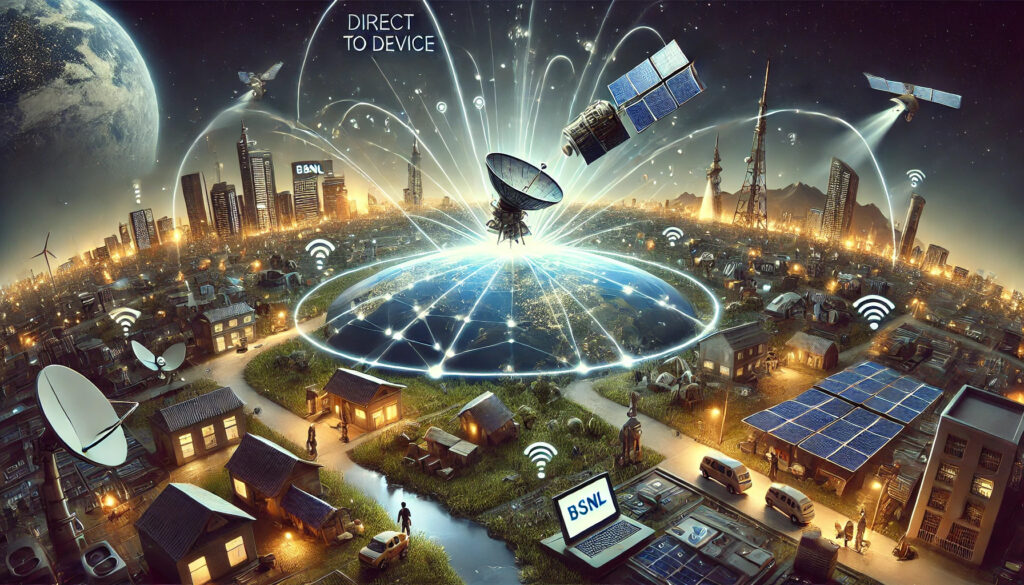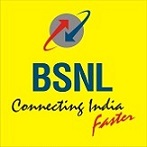The BSNL Direct-to-Device Satellite Service is set to transform how Indians access the internet, especially in remote and underserved areas. As technology advances, reliable and fast internet connectivity is becoming more crucial. In India, where millions still lack access to stable broadband, BSNL (Bharat Sanchar Nigam Limited) is taking a giant leap by introducing satellite-based internet services that can directly connect to users’ devices.

In this blog, we will explore what BSNL’s Direct-to-Device Satellite Service is, its features, and benefits, and how it could reshape the future of digital connectivity in India.
1. Understanding BSNL’s Direct to Device Satellite Service
Bharat Sanchar Nigam Limited (BSNL), the state-owned telecom provider, has recently launched India’s first direct-to-device satellite internet service. This groundbreaking initiative aims to provide high-speed internet access to remote and underserved regions across the country, leveraging advanced satellite technology to deliver broadband connectivity directly to user devices.
The BSNL Direct to Device Satellite Service is a satellite-based internet service that delivers broadband connectivity directly to users’ smartphones, tablets, or other connected devices without relying on traditional ground infrastructure like fiber optic cables or cellular towers. This initiative leverages Low Earth Orbit (LEO) satellites to provide fast, stable, and low-latency internet access.
Direct to Device satellite service enables regular smartphones to connect directly to satellites without requiring any hardware modifications. This technology eliminates the need for traditional cell towers, making it possible to provide connectivity in areas where terrestrial networks are unavailable or impractical.
Key Components
- Low Earth Orbit (LEO) Satellites
- Modified cellular standards
- Standard smartphone hardware
- Specialized ground infrastructure
2. How Does It Work?
Here’s a breakdown of how BSNL’s Direct to Device Satellite Service operates:
- LEO Satellite Network: BSNL is partnering with satellite providers to utilize a constellation of LEO satellites. These satellites orbit closer to Earth compared to geostationary satellites, resulting in faster speeds and lower latency.
- Direct Connectivity: The service allows users to connect directly to the satellite network via their devices. This means users don’t need extensive infrastructure like ground stations or fiber connections to access the internet.
- Seamless Integration: The technology uses advanced receivers and modems built into smartphones and IoT devices, enabling direct satellite communication. This service is expected to integrate seamlessly with existing 4G and 5G devices.
3. Key Features of BSNL Direct-to-Device Satellite Service
Here are some standout features of the BSNL satellite internet service:
- High-Speed Internet: The service aims to provide broadband speeds of up to 100 Mbps, making it suitable for video streaming, online gaming, and other bandwidth-intensive applications.
- Low Latency: Leveraging LEO satellites, this service offers significantly lower latency (less than 50 milliseconds) compared to traditional satellite internet, enhancing real-time communication like video calls and gaming.
- Nationwide Coverage: One of the biggest advantages of satellite internet is its ability to provide coverage across the country, including remote and hard-to-reach regions where traditional broadband infrastructure is unavailable.
- Scalable and Flexible: The service can be quickly deployed without the need for extensive ground infrastructure, making it scalable and flexible for both urban and rural settings.
- Secure Communication: Enhanced security protocols are in place to ensure secure data transmission, making it a reliable option for government, corporate, and individual users.
4. Potential Benefits for India
The introduction of BSNL’s Direct to Device Satellite Service can have far-reaching impacts on India’s digital landscape. Here’s how it can benefit the country:
a. Bridging the Digital Divide
- This service has the potential to bridge the digital divide in India, bringing high-speed internet to rural and remote areas where traditional broadband is not feasible.
b. Empowering Education and Healthcare
- Reliable internet access can revolutionize sectors like education and healthcare, enabling remote learning and telemedicine, especially in underserved regions.
c. Enabling Smart Agriculture
- The service can support smart agriculture by providing farmers with real-time data on weather, soil conditions, and market trends, leading to better decision-making.
d. Enhancing Connectivity for Businesses
- Small and medium enterprises (SMEs) in remote areas can benefit from uninterrupted connectivity, which can help them tap into e-commerce, digital marketing, and other online business opportunities.
e. Disaster Management and Emergency Services
- “During natural disasters, satellite-based communication ensures that emergency services remain operational, providing a lifeline when terrestrial networks are disrupted.
5. BSNL’s Collaboration with Global Satellite Providers
To offer this service, BSNL has partnered with satellite technology companies that operate LEO satellite networks. One of the key collaborators could be OneWeb, which already has a significant presence in the LEO satellite segment. This partnership enables BSNL to leverage existing satellite infrastructure, thereby reducing deployment time and costs.
6. Comparing BSNL Satellite Internet with Other Providers
As India’s internet landscape evolves, other players are also entering the satellite broadband market. Here’s a quick comparison:
| Feature | BSNL Direct to Device | Starlink (SpaceX) | Jio Satellite Broadband |
|---|---|---|---|
| Speed | Up to 100 Mbps | 50-150 Mbps | 100 Mbps (expected) |
| Latency | < 50 ms | 20-40 ms | < 50 ms |
| Coverage | Pan India | Global | Pan India |
| Equipment Cost | Minimal | High (dish required) | Moderate |
| Subscription Fee | Affordable | Premium | Competitive |
7. Expected Pricing of BSNL Direct-to-Device Satellite Service
BSNL is known for offering competitive pricing in the telecom sector. BSNL has yet to officially announce the pricing details of the satellite service, but it is expected to be in line with its commitment to affordability.
Predictions suggest that subscription plans may range between ₹500 to ₹1,500 per month ($6 to USD 18), depending on the speed and data package, making it accessible to a wide range of users.

8. Launch Date and Availability
While there has been no official announcement regarding the exact launch date, BSNL is expected to roll out its Direct to Device Satellite Service in mid to late 2024. The initial rollout will likely focus on rural and remote regions, with gradual expansion to urban areas.
9. Challenges and Future Prospects
While the prospects are exciting, there are challenges to address:
- Regulatory Approvals: Satellite internet services require various regulatory clearances, which can delay the launch.
- Technical Barriers: Ensuring compatibility with existing smartphones and devices will be crucial for widespread adoption.
- Market Competition: BSNL will face stiff competition from global players like Starlink and Amazon’s Project Kuiper.
However, with India’s digital infrastructure rapidly evolving, the future of satellite-based internet looks promising, especially with BSNL’s focus on affordability and accessibility.
10. Conclusion
BSNL’s Direct-to-Device satellite service represents a significant leap forward in India’s telecommunications landscape. By bridging the digital divide and providing universal connectivity, this technology has the potential to transform how Indians stay connected, particularly in remote and underserved areas.
The success of this initiative could set a precedent for similar services worldwide, positioning India as a pioneer in satellite-based mobile communications. As the service evolves and expands, it will likely play a crucial role in achieving India’s digital inclusion goals and supporting the country’s continued technological advancement.
As we move towards a more connected future, BSNL’s innovative satellite service could play a pivotal role in fulfilling India’s digital ambitions and making the dream of Digital India a reality.
Note: Service features and specifications mentioned are based on announced plans and may be subject to change during implementation.
Stay tuned for more updates on the official launch, pricing, and availability of BSNL’s satellite service.
Have questions about BSNL’s Direct to Device Satellite Service? Let us know in the comments below!
Read Also: 5G: The Next Frontier in Connectivity

iQOO 13 5G (Nardo Grey, 12GB RAM, 256GB Storage)
PERFORMANCE: The fastest processor ever powered by the Snapdragon 8 Elite mobile platform with a clock speed of 4.3GHz, 3Mn+ Antutu Score. The CPU features the first-ever 2 + 6 all-big-core architecture and an all-new 3nm process. In addition to that, it has LPDRR5X Ultra, UFS 4.1 storage, 6000mAh -3rd Generation silicon anode battery, 0.813cm ultra slim design & 120W fast charger. Also, iQOO13 is IP68+IP69 rated for dust and water resistance.
Frequently Asked Questions (FAQs)
A. While an official launch date has not been confirmed, the service is expected to roll out in phases, starting in mid to late 2024. Initial deployment will focus on remote and underserved regions, with gradual expansion to urban areas.
A. BSNL’s satellite service aims to offer speeds of up to 100 Mbps, making it suitable for activities like video streaming, online gaming, and video conferencing.
A. The latency is expected to be below 50 milliseconds due to the use of LEO satellites, which orbit closer to Earth compared to traditional geostationary satellites. This ensures a smoother experience for real-time applications like online gaming and video calls.
A. While official pricing details are yet to be announced, it is expected that BSNL will offer competitive rates, with subscription plans likely to range between ₹500 to ₹1,500 per month depending on speed and data packages.
A. The service leverages LEO satellites to provide internet connectivity directly to devices. It eliminates the need for dishes or ground-based equipment, making it convenient for users in remote or hard-to-reach areas. Users connect to the satellite network using built-in receivers in their devices.
A. Yes, one of the main advantages of satellite internet is that it offers nationwide coverage, especially in areas where traditional broadband infrastructure is not available. It’s ideal for remote villages, hilly terrains, and isolated regions.





